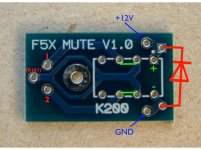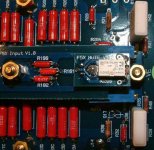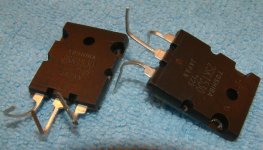The "mute" is not a function like the normal Mute in a preamp.
Rather it shorts the input via the incoming 1k resistors (to avoiding loading the preamp excessively) so that in case of a fault we can excute a controlled shut down.
The protection board is designed to do that for you.
So no there is not a separate button to mute the power amp, if you that is what you meant.
Patrick
Rather it shorts the input via the incoming 1k resistors (to avoiding loading the preamp excessively) so that in case of a fault we can excute a controlled shut down.
The protection board is designed to do that for you.
So no there is not a separate button to mute the power amp, if you that is what you meant.
Patrick
Here is as promised a connection diagram for the Protection PCB configuration switches.
To have the relay terminals OC when a control signal is asserted put a wire across the pins in the on column. Put a wire in the foo column everywhere else.
OFF is asserted when the amplifier is in off mode
SBY is asserted when the amplifier is in standby mode
TRP is asserted after a fault has occurred.
SUD is asserted while the protection board is turning on.
Regards.
Edit: almost forgot to attach the file
Alexis,
could you possibly explain a little better so that even I might understand a fraction🙂
Maybe simply by showing a photo of the recommended jumper configuration for a complete standard build with power, speaker, input and mute relays. Preferably together with a brief description of what this configuration does to the amp when this changes between different states (off, standby, on and fault - I assume).
How can a fault condition be simulated to test the circuit?
Any suggestions for suitable board-to-wire connectors (2 mm pitch I think)?
Thanks,
Nic
Standby in the sense that the current is switched off will indeed only work with the regulator.
So I do hope those Regulator alpha testers will test them soon.
Patrick
So I do hope those Regulator alpha testers will test them soon.
Patrick
correct configuration of the mute board
Of course Dave and Patrick are wright so here is the correct (and tested) configuration of the mute board. I misread the relay data sheet and got the coil polarity wrong (topside view for through-hole versions and bottom view for surface mount versions😡)
I also succeeded in getting the polarity of the diode wrong...... Nothing serious happens: a tiny bit of smoke and a short🙄
That is why you should not follow my example😀
Of course Dave and Patrick are wright so here is the correct (and tested) configuration of the mute board. I misread the relay data sheet and got the coil polarity wrong (topside view for through-hole versions and bottom view for surface mount versions😡)
I also succeeded in getting the polarity of the diode wrong...... Nothing serious happens: a tiny bit of smoke and a short🙄
That is why you should not follow my example😀
Attachments
Hi Patrick,
Which means the mute only goes into action when there's a fault with the amplifier. The board will mute the pre-amp and also cut off speaker connection at that moment as well. Then we can turn off the amp. Is this true?
Thanks.
PMChoong
Which means the mute only goes into action when there's a fault with the amplifier. The board will mute the pre-amp and also cut off speaker connection at that moment as well. Then we can turn off the amp. Is this true?
Thanks.
PMChoong
The "mute" is not a function like the normal Mute in a preamp.
Rather it shorts the input via the incoming 1k resistors (to avoiding loading the preamp excessively) so that in case of a fault we can excute a controlled shut down.
The protection board is designed to do that for you.
So no there is not a separate button to mute the power amp, if you that is what you meant.
Patrick
> Which means the mute only goes into action when there's a fault with the amplifier.
And during start up.
So you can, if you like warm up your FETs first before playing music.
> The board will mute the pre-amp and also cut off speaker connection at that moment as well. Then we can turn off the amp.
Yes.
If an amp is at fault, you don't want single to go through it anyhow.
So better to ground the inputs.
The F5X preamp has a different, remote-controllable mute function to silent its output at any time.
That is the normal Mute that people know in their amplifier.
Patrick
And during start up.
So you can, if you like warm up your FETs first before playing music.
> The board will mute the pre-amp and also cut off speaker connection at that moment as well. Then we can turn off the amp.
Yes.
If an amp is at fault, you don't want single to go through it anyhow.
So better to ground the inputs.
The F5X preamp has a different, remote-controllable mute function to silent its output at any time.
That is the normal Mute that people know in their amplifier.
Patrick
Hi Nic, would you post a picture of your mute board?
Attachments
Thanks guys.
Nic, your 220R resistors have copper connecting leads? The color in the photos looks like copper.🙂
Nic, your 220R resistors have copper connecting leads? The color in the photos looks like copper.🙂
Just poor lightening in my photo. They are the "ordinary" GB PRP's. I think the leads (non-magnetic) are tinned copper.Nic, your 220R resistors have copper connecting leads? The color in the photos looks like copper.🙂
Nic, so are your output FETs installed and the amp boards adjusted/trimmed out now? Seems like you are getting close.
I'm a couple of steps behind you.
I'm a couple of steps behind you.
Patrick,
any tips and tricks for bending MOSFET legs?
I'm sure I can handle, but you always seems to know a better way😉
Cheers,
Nic
any tips and tricks for bending MOSFET legs?
I'm sure I can handle, but you always seems to know a better way😉
Cheers,
Nic
Measure the required distance first.
Mark it with a caliper.
Use a vice or a pair of long nose pliers.
Practice makes perfect (of course using some cheap FETs). 🙂
Patrick
Mark it with a caliper.
Use a vice or a pair of long nose pliers.
Practice makes perfect (of course using some cheap FETs). 🙂
Patrick
Just joking......🙂
These are fakes that I picked up on the way🙁
Perfect for practicing😉
Back to business: from what I can see/measure the inner set of holes on the PCB will make the best fit (or bending will have to exceed 90˚)
Cheers,
Nic
These are fakes that I picked up on the way🙁
Perfect for practicing😉
Back to business: from what I can see/measure the inner set of holes on the PCB will make the best fit (or bending will have to exceed 90˚)
Cheers,
Nic
Just joking......🙂
These are fakes that I picked up on the way🙁
Perfect for practicing😉
Back to business: from what I can see/measure the inner set of holes on the PCB will make the best fit (or bending will have to exceed 90˚)
Cheers,
Nic
hello. where do you get sj201/sk1530?
i've found some at salon. but i don't know if they may be fakes.
- Home
- Amplifiers
- Pass Labs
- F5X -- the EUVL Approach - The Build Thread


